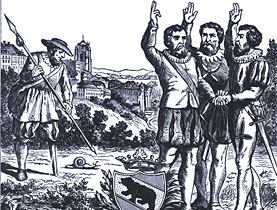Popular calendars change with the times

Every year a one-legged messenger informs and entertains thousands of people in Switzerland, just as he has for the past three centuries or so.
The “Hinkende Bot”, or “Limping Messenger”, is one of several almanacs that have survived the passage of the years. They are the relic of a very different past, when most people lived on the land, when society was rigidly stratified, and when the population was much less mobile than today.
They are by nature conservative, and yet they have had to be highly adaptable in order to survive.
Historians at Zurich University have been researching the history of these popular calendars, with support from the Swiss National Science Foundation. The calendars provide a unique insight into what information was available to ordinary people.
Annual review
The yearly review of news was one major feature of the almanacs then as now, very important in pre-newspaper days. In the 18th century it focussed on such things as wars, disasters, royal weddings and papal elections. Given the strict censorship of the time, local news was usually avoided.
“Until about 1750 we can presume that it really was news to its readers,” Norbert Wernicke, a historian with the Zurich Volkskalender project told swissinfo. But as newspapers started appearing more frequently, the almanacs had to adapt.
“The review started to look back, trying to give more background information,” he explained. “And they had to look for a new niche, presenting information that wasn’t so time-bound.”
On the one hand this meant literary texts and entertainment, a trend which started around 1770. The literary texts were often sentimental or amusing tales, sensational news items or anecdotes, perhaps about European leaders like Frederick the Great of Prussia or Napoleon – but certainly not about local rulers. Even puzzles became a regular feature of the Zurcher Kalender from about 1780.
On the other hand, the almanacs were used by scholars and clergymen to preach virtues like thrift and discipline, but more practical matters too. “They spread information about new farming methods and more efficient accounting, and so on,” said Wernicke.
A mixture was essential. A purely didactic calendar published in St Gallen lasted for only four years, from 1790 to1794.
“Two hundred years ago the calendar was a modern medium, which played an important role in the media landscape,” Wernicke commented.
And today…
The case is very different today. Readers are attached to tradition, and so many of the articles in the modern almanac have a historical focus.
Bruno Benz, the current editor of the Bernese “Hinkende Bot”, told swissinfo that he always looks for anniversaries. In the 2008 edition, for example, there is an article on the 18th century scholar Albrecht von Haller, born exactly 300 years ago.
Another regular feature he has introduced is an article about the historical development of a particular town or village in the canton.
But the almanac does not only consist of articles. It begins with a calendar with space for notes, something which has not changed.
“You always found these calendars in farmers’ houses. They made a hole and hung it up… The farmer put in the most important things that happened on his farm over the year,” Benz explained.
The list of markets is also a constant and still important. “Almost every year we get complaints if a market isn’t mentioned or we have given the wrong date,” said Benz.
For the publisher Stämpfli, which has produced the “Hinkende Bot” since 1815, it is a prestige item, and they are confident it has a future.
About twenty years ago the “Hinkende Bot” took a poll of its readers. The overall response was: “Leave everything as it is.”
But perhaps those readers would be surprised if they looked at early calendars and saw just how much has changed.
swissinfo, Julia Slater
Popular calendars first appeared in the 16th century. They were the forerunner of newspapers.
They included a calendar with astrological and other information as well as a space for notes. Farmers used to hang them up and record the major events of the year.
A major feature was a review of world events. They also contained literary and informative articles.
The Volkskalender project of Zurich University is making a database of the contents of all the existing Swiss calendars in German from 1500 to 1900.
The popular calendars still published in Switzerland include the Appenzeller Kalender, the Bünderkalender and the Hinkende Bot in German, and the Messager Boiteux in French.
They are issued in the early autumn for the following year.
The Bernese Hinkende Bot currently has a print run of about 20,000.
It has been published by Stāmpfli publishers of Bern since 1815.

In compliance with the JTI standards
More: SWI swissinfo.ch certified by the Journalism Trust Initiative
You can find an overview of ongoing debates with our journalists here . Please join us!
If you want to start a conversation about a topic raised in this article or want to report factual errors, email us at english@swissinfo.ch.